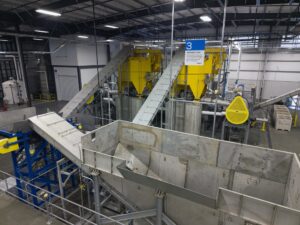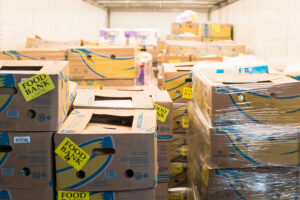April 16, 2025
In this blog: Retailer obstacles to donation | Role of data & technology | MealConnect | Divert + Feeding America partnership | Data insights to drive donations | Donation optimization through co-training
Summary: In this Q&A with experts from Feeding America and Divert, we explore the role that data and technology can play in identifying donation opportunities for retailers, and how targeted education campaigns can optimize donation efforts over time, even for top-performing stores.
Nearly 50 million people in the U.S. face food insecurity, a number that is likely to rise in response to continued inflation. As food and commodity prices continue to fluctuate, companies across the value chain are seeking strategies to manage operational risks while still delivering on their ESG commitments. This time of heightened uncertainty and food insecurity underscores a critical need for innovative solutions that can bolster food recovery efforts.
We sat down with David Loomis, Director of Supply Chain Technology at Feeding America and Jess Parker, Food Recovery Program Manager at Divert, to discuss how the two organizations are partnering together to help food industry businesses optimize donations through fresh data and coordinated training campaigns.
What are some of the challenges retailers face in donating unsold food today? What keeps stores from donating more of their surplus to local food banks?

David Loomis: I see there being two things that are key challenges that they face. First is knowledge of what’s donatable. This information usually exists at that parent corporate level, but may not always reach folks in the stores who are making item-by-item donation decisions. And then secondly, corporate offices need donation data in order to understand which stores are at level with donations and which may need some more targeted training to ensure that as much nutritious, healthy food (that can’t be sold) is going to its best and highest use of helping to end hunger.

Jess Parker: Completely agree with you there, David. Some of the things that we also see whenever we’re going into stores is that stores have many competing priorities. Associates are responsible for many tasks throughout their day and often face staffing challenges or deal with employee turnover. Unfortunately, sometimes that means that donations and their diversion programs aren’t prioritized, and consistent training becomes more of a challenge.
Let’s also think about the scale of the problem – we’re talking about thousands of grocery stores across the country with thousands of associates who are all making decisions on a daily basis about what to donate. When you’re dealing with that many stakeholders, it can be challenging to get everybody on the same page and instill a company culture of donation.
We’re talking about thousands of grocery stores across the country with thousands of associates who are all making decisions on a daily basis about what to donate. When you’re dealing with that many stakeholders, it can be challenging to get everybody on the same page and instill a company culture of donation.
–Jess Parker, Divert
You make a great point about the scale of the problem, Jess. With thousands of stores and thousands of associates in those stores making donation decisions, how can data and technology play a role in making those decisions easier, and fostering a company culture of donation?
David: Certainly providing that guidance of what is donatable in a visual manner, as we’ve done at Feeding America with our MealConnect app, helps make those decisions easier. And we also provide retailers and food banks with store-by-store performance insights so that they know where additional support may be needed to ensure that all stores are donating and meeting corporate expectations.
Jess: Right, and on the Divert end of things, we’re providing fresh data that retailers haven’t had access to before. Historically, when we think about data on unsold food, there was really no understanding of what kind of food was going into the trash on a daily basis. It was a black box. There was scan-out data, but based on industry studies, that data can be largely inaccurate. There was also no understanding of what was actually donatable, of the food that was thrown away. Divert is helping to create new data and information that allows retailers to gain visibility into the opportunity to improve their donations and mark downs and reduce waste.
Let’s talk more about MealConnect and how it came to be.
David: MealConnect is Feeding America’s free-to-use national platform for sourcing and sharing rescued food at scale.
It started in 2014 with a web-based app and a focus on retail rescue, the key function being to help food banks organize and track food rescue pickups at grocery stores. The team wanted to not just make data available but make it accessible and digestible. We’ve worked to make our solution intuitive and easy to use for those store associates who may be new to the system and don’t have a lot of training.
What has the timeline of Meal Connect been like in terms of adoption and volume of food rescued? How have you seen it grow over the years?
David: We started with agencies like food pantries and meal programs in 2014, giving them the ability to track donations flowing through agencies across states and stores. We later expanded that to include disaster support and supply chain disruptions, so for example, if a region had a flood and the retailer couldn’t get a shipment of strawberries to a store, they could put them on MealConnect and donate them to the nearest food bank. In 2018, we gave manufacturers a way to post their stranded or rejected loads in MealConnect and connect with the nearest food bank on their route. We launched the mobile version of MealConnect in 2023.
With all of these improvements, we’ve essentially doubled the throughput of food that flows through MealConnect in the last five years. In 2019, we had roughly 49 million pounds of dairy versus 91 million pounds in 2024. In 2019, we saw 189 million pounds of fresh produce, versus 676 million pounds in 2024. We see an average increase of 33% in rescued pounds once a food bank joins MealConnect. So, the impact is huge because we’re making it really easy to capture those opportunities in order to provide safe, healthy options for people facing hunger, giving perfectly good food a second chance.
Last year, Feeding America announced an ambitious goal to rescue an additional one billion pounds of unsold food annually, and later announced a collaboration between Feeding America and Divert to provide retailers with more visibility to optimize their donation efforts. How is this collaboration helping accelerate food rescue for Feeding America and its retail partners?
David: Great question. Our amazing retail partners clearly play a crucial role in our food rescue efforts. Together, we are not just rescuing food, but with MealConnect and Divert’s insights, we are changing the way communities access it.
The waste audits that we do with retailers really help us identify the opportunities at the store level to optimize donations. Secondly, our combined data points paint a holistic picture of how stores – and departments within stores – are handling their unsold items. That holistic picture allows us to compare performance against industry benchmarks and understand which stores need additional support in operationalizing donations.
Together, we are not just rescuing food, but with MealConnect and Divert’s insights, we are changing the way communities access it.
–David Loomis, Feeding America
Are there specific data points that often come up when you’re comparing MealConnect and Divert data that indicate opportunities to improve donations?
David: For Feeding America, it is pounds donated and that comparison across stores in a region that make it easy to see the outliers and take action.
Jess: Yes, and just to add to that: noticing a drop in donations from a store that was once a strong contributor. That’s definitely an indicator that something has happened, maybe a staffing change, and they need additional support.
At the same time, strong donators may still need support as well. If you look at raw donation pounds from a store on MealConnect, they may seem like a strong donator, but if you compare it with Divert bin data, their donations may all be coming from bakery or meat departments – they’re not donating as much fresh produce as they could be. That indicates a gap between different departments and represents a real opportunity for improvement. That’s where Divert and Feeding America can come in, offering a really granular analysis and helping them refine their training to make a measurable difference.
I think this is evident through Feeding America’s Food Rescue Challenge; we know there’s more out there to be rescued. We’re trying to frame that story around the data so that retailers can understand where their opportunities are and, ultimately, try to orient the industry as a whole around those.
…we know there’s more out there to be rescued. We’re trying to frame that story around the data so that retailers can understand where their opportunities are and, ultimately, try to orient the industry as a whole around those.
–Jess Parker, Divert
Once a store has that data, how does this partnership between Feeding America and Divert help improve the store’s performance?
Jess: Once we’re able to ingest both the MealConnect data and Divert data, we’re able to better pinpoint which areas within a store need the most support and attention, and then craft customized, coordinated education campaigns and interventions. Both Feeding America and Divert have field teams that go into stores regularly and can have those personal interactions. They can actually work with associates down to the department level to set up systems and processes that will increase donations over time.
It takes more than one touch point with a store to create that culture of accountability. Stores need sustained support over time to move the needle in a meaningful way. Oftentimes, the model we see among retailers is that one person owns the donation program for an entire chain, so they don’t necessarily have the bandwidth to get down to that level of granularity, let alone improve it on their own. So together we’re not only able to offer them that granular analysis to identify opportunities, but we’re also able to provide training support to refine their processes. We’ve had success working with Feeding America’s partner food banks in a number of regions to work with stores, drill down into specific categories, and work with those stakeholders and associates to identify the changes that will make donation a daily routine.
It’s through executing these coordinated campaigns with local Feeding America food banks that we’re seeing impressive results – up to a 20% increase in donations, reductions in trash volumes and costs, etcetera. It’s by bringing together Divert data and Meal Connect data that we’ve been able to do this.



